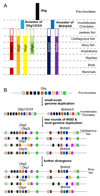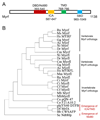Evolution of the CNS myelin gene regulatory program
- PMID: 26474911
- PMCID: PMC6326354
- DOI: 10.1016/j.brainres.2015.10.013
Evolution of the CNS myelin gene regulatory program
Abstract
Myelin is a specialized subcellular structure that evolved uniquely in vertebrates. A myelinated axon conducts action potentials many times faster than an unmyelinated axon of the same diameter; for the same conduction speed, the unmyelinated axon would need a much larger diameter and volume than its myelinated counterpart. Hence myelin speeds information transfer and saves space, allowing the evolution of a powerful yet portable brain. Myelination in the central nervous system (CNS) is controlled by a gene regulatory program that features a number of master transcriptional regulators including Olig1, Olig2 and Myrf. Olig family genes evolved from a single ancestral gene in non-chordates. Olig2, which executes multiple functions with regard to oligodendrocyte identity and development in vertebrates, might have evolved functional versatility through post-translational modification, especially phosphorylation, as illustrated by its evolutionarily conserved serine/threonine phospho-acceptor sites and its accumulation of serine residues during more recent stages of vertebrate evolution. Olig1, derived from a duplicated copy of Olig2 in early bony fish, is involved in oligodendrocyte development and is critical to remyelination in bony vertebrates, but is lost in birds. The origin of Myrf orthologs might be the result of DNA integration between an invading phage or bacterium and an early protist, producing a fusion protein capable of self-cleavage and DNA binding. Myrf seems to have adopted new functions in early vertebrates - initiation of the CNS myelination program as well as the maintenance of mature oligodendrocyte identity and myelin structure - by developing new ways to interact with DNA motifs specific to myelin genes. This article is part of a Special Issue entitled SI: Myelin Evolution.
Keywords: Evolution; MyRF; Myelin; Olig1; Olig2; Oligodendrocyte; Phylogeny; Transcription factor.
Copyright © 2015 Elsevier B.V. All rights reserved.
Figures



Similar articles
-
The evolution of Olig genes and their roles in myelination.Neuron Glia Biol. 2008 May;4(2):129-35. doi: 10.1017/S1740925X09990251. Neuron Glia Biol. 2008. PMID: 19737433 Free PMC article. Review.
-
Interactive Repression of MYRF Self-Cleavage and Activity in Oligodendrocyte Differentiation by TMEM98 Protein.J Neurosci. 2018 Nov 14;38(46):9829-9839. doi: 10.1523/JNEUROSCI.0154-18.2018. Epub 2018 Sep 24. J Neurosci. 2018. PMID: 30249802 Free PMC article.
-
Evolution of myelin ultrastructure and the major structural myelin proteins.Brain Res. 2016 Jun 15;1641(Pt A):43-63. doi: 10.1016/j.brainres.2015.10.037. Epub 2015 Oct 28. Brain Res. 2016. PMID: 26519753 Review.
-
A Bacteriophage tailspike domain promotes self-cleavage of a human membrane-bound transcription factor, the myelin regulatory factor MYRF.PLoS Biol. 2013;11(8):e1001624. doi: 10.1371/journal.pbio.1001624. Epub 2013 Aug 13. PLoS Biol. 2013. PMID: 23966832 Free PMC article.
-
MYRF is a membrane-associated transcription factor that autoproteolytically cleaves to directly activate myelin genes.PLoS Biol. 2013;11(8):e1001625. doi: 10.1371/journal.pbio.1001625. Epub 2013 Aug 13. PLoS Biol. 2013. PMID: 23966833 Free PMC article.
Cited by
-
ST8SIA2 promotes oligodendrocyte differentiation and the integrity of myelin and axons.Glia. 2017 Jan;65(1):34-49. doi: 10.1002/glia.23048. Epub 2016 Aug 18. Glia. 2017. PMID: 27534376 Free PMC article.
-
CNS myelination and remyelination depend on fatty acid synthesis by oligodendrocytes.Elife. 2019 May 7;8:e44702. doi: 10.7554/eLife.44702. Elife. 2019. PMID: 31063129 Free PMC article.
-
Voltage-Gated Ion Channels Are Transcriptional Targets of Sox10 during Oligodendrocyte Development.Cells. 2024 Jul 7;13(13):1159. doi: 10.3390/cells13131159. Cells. 2024. PMID: 38995010 Free PMC article.
-
The Oligodendrocyte Transcription Factor 2 OLIG2 regulates transcriptional repression during myelinogenesis in rodents.Nat Commun. 2022 Mar 17;13(1):1423. doi: 10.1038/s41467-022-29068-z. Nat Commun. 2022. PMID: 35301318 Free PMC article.
-
Clemastine Promotes Differentiation of Oligodendrocyte Progenitor Cells Through the Activation of ERK1/2 via Muscarinic Receptors After Spinal Cord Injury.Front Pharmacol. 2022 Jul 5;13:914153. doi: 10.3389/fphar.2022.914153. eCollection 2022. Front Pharmacol. 2022. PMID: 35865954 Free PMC article.
References
-
- Anitei M, Pfeiffer SE. Myelin biogenesis: sorting out protein trafficking. Curr Biol. 2006;16:R418–R421. - PubMed
-
- Arnett HA, Fancy SP, Alberta JA, Zhao C, Plant SR, Kaing S, Raine CS, Rowitch DH, Franklin RJ, Stiles CD. bHLH transcription factor Olig1 is required to repair demyelinated lesions in the CNS. Science. 2004;306:2111–2115. - PubMed
-
- Bramblett DE, Copeland NG, Jenkins NA, Tsai MJ. BHLHB4 is a bHLH transcriptional regulator in pancreas and brain that marks the dimesencephalic boundary. Genomics. 2002;79:402–412. - PubMed
-
- Bramblett DE, Pennesi ME, Wu SM, Tsai MJ. The transcription factor Bhlhb4 is required for rod bipolar cell maturation. Neuron. 2004;43:779–793. - PubMed
Publication types
MeSH terms
Substances
Grants and funding
- 066745/WT_/Wellcome Trust/United Kingdom
- BB/L003236/1/BB_/Biotechnology and Biological Sciences Research Council/United Kingdom
- BBJ006602/1/BB_/Biotechnology and Biological Sciences Research Council/United Kingdom
- 293544/ERC_/European Research Council/International
- G0800575/MRC_/Medical Research Council/United Kingdom
LinkOut - more resources
Full Text Sources
Other Literature Sources
Miscellaneous

